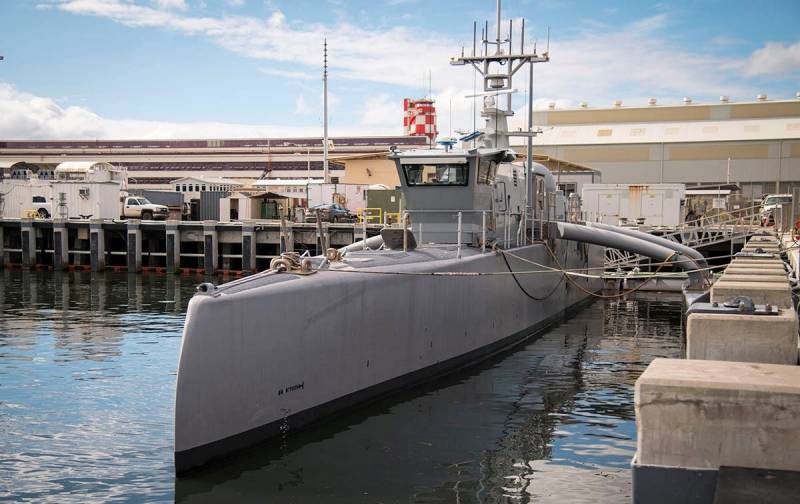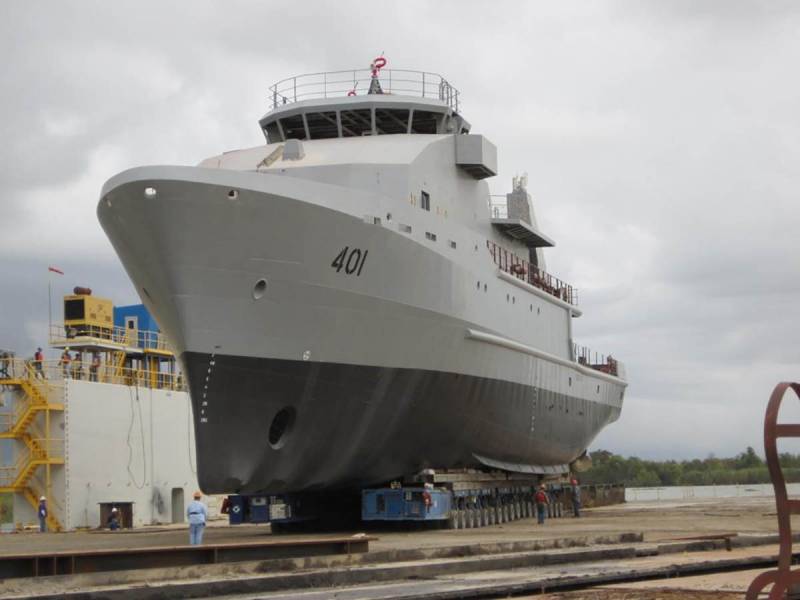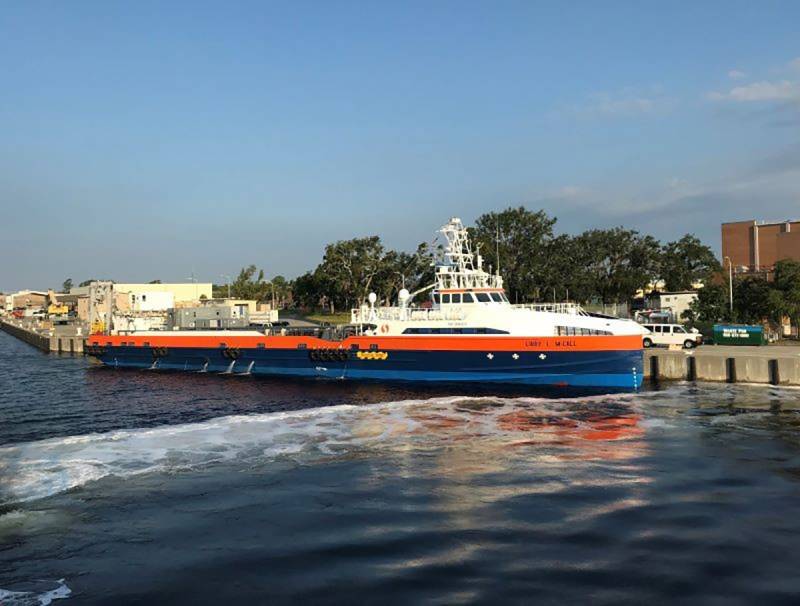For the sake of uninhabited platforms, the US Navy is ready to give up to many
Although much has been written about the surface strategy fleet The United States and the desire to increase the number of ships, no less strongly his desire to shift the focus on the use of uninhabited surface combat weapons.
In 2020, the U.S. Navy plans to complete a couple of significant projects aimed at accelerating the adoption of uninhabited surface vehicles (NNA) as a part of the surface combat fleet, which is a notable modernization initiative with the prospect of a radical reformatting of the naval forces, long-term plans for shipbuilding, as well as tactical receptions and methods of warfare.
One of the issues that is planned to be solved in the first half of this year is determining the configuration of the surface combat flotilla with special attention to how many and how large autonomous vessels the fleet needs, as well as to analyze with a focus on costs and organizational structure of forces. At the end of the year, it is planned to complete the development of the concept of combat use for NNA, which defines the main strategy for the adoption of autonomous combat vehicles equipped with missiles and sensors in the fleet.
This activity is the result of disagreements between the fleet and the Trump administration in December 2020 over long-term plans for the construction of ships. At the same time, the fleet opposed the reduction of 12 warships between 2021 and 2025 in order to redirect the saved 10 billion dollars to new priorities, including uninhabited systems. In response, the White House demanded that the fleet restore the proposed reductions. The outcome of these “swings” will be visible in the fleet’s budget request for fiscal year 2021, which was sent to Congress earlier this year.
Strategic transition
The background to current budgetary intrigues is the 2018 National Defense Strategy, which stipulates that the U.S. military, after nearly two decades of irregular wars in Afghanistan and Iraq, focuses on a potential confrontation with China or Russia.
This strategy, especially its emphasis on the use of new technologies, such as autonomy and artificial intelligence, forces the US fleet to actively engage in the development of its uninhabited platforms and the principles of their combat use.
The US Navy currently has 293 warships in its composition and plans to increase this number to 355 units, although this could take about ten years, subject to stable and generous funding, which has not yet been available. historical precedents. As the incumbent US Secretary of the Navy, Thomas Modley, admitted last September, "This cannot be done within a reasonable time frame." But in December he said: “The fleet is too small. Our capabilities are based on a small number of huge ships and this needs to be changed over time. "
Despite the fact that the Navy takes into account the low rate of increase in the fleet, they are developing a new concept in support of the National Defense Strategy, called "dispersed naval operations", which provides for a wider distribution of the fleet in the era of confrontation between the great powers.
“In order to get such dispersal — and the ability to create this dispersal — we need more platforms to deploy more weapon systems and sensors,” said Pete Small, Program Manager for Marine Uninhabited Systems. “Uninhabited systems come into play here.”
The fleet is looking at the potential of the medium and large NNA fleet regarding the installation of missiles and sensors on them (currently widely installed on crew vessels), which allows these platforms to be sent to unsafe disputed areas with less risk.
The plans provide for the addition of a manned surface fleet to these platforms without any replacement for the current traditional warships.
Balance the concept of containment
China and Russia have invested heavily in the development of capabilities, for example, long-range air defense, high-precision ballistic and cruise missiles, submarines and long-range radars, as well as in sophisticated operational control systems that can be directed in one way or another to deployed American forces. The fleet believes that it will be able to partially balance these so-called A2 / AD capabilities (Anti-Access / Area Denial - the concept of deterring the enemy (usually a set of weapons) by creating an increased danger for the deployment or movement of enemy forces in a protected area) by adopting platforms like NNA.
For example, in the Navy they are studying what can be achieved if the destroyer DDG-51 of the “Arly Burke” class works in tandem with a large NNA armed with missiles and an average NNA equipped with sensor kits. “We can send the average NNA closer or even inside the A2 / AD zone and make them the sensor nodes that we need to send information from this zone to the inhabited platforms,” said Small. - Further, based on this information, the habitable platform now has more options, acting in conjunction with a large NNA, since a large NNA adds more features. And he offers various concepts of target designation and firing, which were not available when you had only one inhabited platform. "
He continued:
This dispersed configuration gives the US military much more options when performing a combat mission and vice versa creates more problems for the enemy. "And this turns into an increased advantage in this combat scenario."
Alternative analysis
The representative of the Office of surface combat operations in the structure of the US Navy noted that they conducted an assessment lasting a whole year, the results of which will give recommendations on the ratio of inhabited and uninhabited ships in the fleet. It is expected that the analysis currently being discussed by fleet and command commanders will help determine for the future fleet a combination of large surface ships (e.g. destroyers and cruisers), small surface combat ships (e.g. coastal combat ships and the planned FFG (X) frigate) as well as large and medium NNAs.
To date, the fleet has developed a “pyramid concept” with large surface ships — most of them powerful and expensive platforms — at the top, supported by a large number of smaller surface ships, which are multitasking but cheaper. The next in the scheme may be a larger number of large NNAs, which, while not being as functionally capable as small surface warships, can deliver a powerful impact at a lower cost. Finally, the pyramids are based on the most inexpensive medium NNAs in this combination, and therefore the fleet can afford to purchase them in large quantities.
The data from this assessment will help formulate long-term plans for the costs and construction of fleet ships, which are planned to be implemented in 2022.
However, it should be borne in mind that over the past 25 years, although the US Navy has paid attention to uninhabited technologies for air, surface and underwater tasks, they have relatively slowly adopted such systems.
“From a historical point of view, the fleet generally adhered to a balanced and not always quick approach to uninhabited technology. This refers to the inclusion of an unmanned aircraft in the aircraft carrier, and then of course to the surface and underwater areas. This is undoubtedly a serious challenge - to accept a large number of large and medium NNAs into the fleet. ”
Design progress
The US Navy launches new development and procurement projects for large and medium-sized NNAs, although some of these projects were not originally intended for it. This is due to the fact that the Navy command has now set itself the goal of obtaining a more diverse fleet.
In 2010, the DARPA Office began designing an uninhabited ship based on the premise that a person would not step aboard at any stage of the operations cycle. This project has evolved into the ACTUV (Anti-Submarine Warfare Continuous Trail Unmanned Vessel) submarine anti-submarine program. Leidos has committed to building and testing an experimental platform to demonstrate the technical feasibility of autonomous vessels operating in a theater of flight or potentially global distances.
In 2018, a prototype ACTUV trimaran was named Sea Hunter and transferred to the Office of Naval Research, after which the Navy talked about its huge potential, which could bring qualitatively new capabilities to the fleet.
The Sea Hunter project gave impetus to the implementation of plans for a low-cost average NNA with a long duration of work, which could be configured for various types of target loads. The primary concern for this class is electronic warfare, as well as intelligence and information gathering.
The fleet's budget request for 2020 states:
Size increase
Similarly, the fleet deals with large NNAs, for example, three years ago, the Ghost Fleet Overlord program was launched in the bowels of the US Department of Defense. Within the framework of this project, commercial fast delivery ships used by the oil and gas industry for servicing offshore drilling rigs are adapted and converted into experimental large NPAs in order to use the volume intended for commercial cargo for modular combat target loads.
In September 2019, Phase 1 of the Ghost Fleet Overlord program was completed. In this phase, the two industry groups involved in the project, led by Gibbs & Cox and L3 ASV, have redesigned a pair of existing fast delivery vessels into NVA, including autonomous systems integration, demonstration of seaworthy autonomy and over 600 hours of testing.
Stage 2 began in October 2019 and will continue until the fall of 2021. According to the US Navy, it focuses on the integration of operational management systems and target loads. “This new phase allows us to conduct additional reliability tests, integrate autonomy systems and deepen the integration of state-provided operational management systems that are designed for medium and large NNAs,” said Small. “All this experience gained in the Overlord Stage 2 program will be used in our work on medium and large NNAs.”
Parallel project
In parallel with the Overlord program, the fleet is implementing a parallel project to develop a large NNA on the basis of a vessel 60-90 meters long with a displacement of about 2000 tons. In September, he issued proposals for a large apparatus, which said: "A reconfigurable vessel with a long sailing time, capable of accepting various target loads for uninhabited tasks in order to complement the capabilities of inhabited surface ships of the American fleet."
- says the proposal of the fleet.
“We are currently evaluating a number of proposals in the context of the concept of a major NNA,” added Small. “We will issue several orders to a number of industrial enterprises, which will help us further develop the requirements and concepts of a large NNA with an integrated launcher.”
The goal is to issue the first major NPA contracts by 2023 as part of this priority program. Congress allocated budget funds for two large surface vehicles, which the fleet requested for 2020 (ships will be in the Overlord configuration), but at the moment it has strongly forbidden the fleet to integrate the vertical launch system into a large NNA. The US Navy intends to use these additional vessels to increase the volume of experiments and gain experience, as well as the development of an integrated solution.
Program Promotion
Along with its large NNA programs, the U.S. Navy is implementing long-term plans for the purchase of uninhabited surface and underwater systems, which appeared before the National Defense Strategy 2018.
In August 2019, small-scale production of the Knifefish uninhabited underwater vehicle (NPA), designed to detect submarine mines deployed from warships, began.
Last November, the operational evaluation of the Unmanned Influence Sweeping System manufactured by Textron was completed; this year a decision should be made on his future fate, possibly on the start of mass production.
Two Razorback airbags, based on the Hydroid project, were delivered in July 2019 to the so-called Squadron of Uninhabited Submarines No. 1 in Washington State.
Boeing, having teamed up with Huntington Ingalls, received a contract for the construction of five super-large air-raids, the first of which should be delivered in 2021.
The Newport Submarine Warfare Center oversees the production of a prototype of the Snakehead large displacement prototype, which is scheduled to be launched in 2021.
Industry Senses
This trend of development of smaller platforms means that, most likely, the fleet’s plans for building ships and, in a broader sense, the industrial base are changing.
“It’s very interesting, the oversaturated market can really change what has supported the status quo in shipbuilding for 40 years, or maybe longer,” said Small. - We are waiting for new challenges and opportunities related to the very aggressive competition of all these latest platforms or new types of tasks. I believe a lot will come down to what requirements and standards the fleet is going to set for these unconventional ships and vehicles and this will really determine the rules of the game for all participants in a highly competitive market. ”
New organization
In 2020, the U.S. Navy should undoubtedly take up the study of issues related to the integration of these unconventional platforms into the fleet.
In order to prepare for the adoption of the NNA, the fleet in May 2019 organized a new unit - the SURFDEVRON (Development Development Squadron) 1 surface fleet development squadron in San Diego. The task of the new unit, in particular, is to support development work and accelerate the development of new combat capabilities and concepts.
One of the first projects is the development of official principles for the combat use of NNA, which is planned to be completed during 2020. “This is a big step,” said Henry Adams, SURFDEVRON ONE squadron commander. “There is still a lot of work ahead and it will take a lot of time, but I think we should all finish by the end of this year.”
This document will become the organizational operational basis for how the fleet should operate the NNA. “The principles of combat use will pull everything from logistics to maintenance and operation of the system on the high seas. Therefore, we have a lot of work to do this year. ”
In December, the fleet transferred all responsibility for the Sea Hunter apparatus from the Marine Research Directorate to SURFDEVRON. The San Diego Command is now responsible for the existing single average NNA. Upon completion of construction at the end of 2020, the second Sea Hunter will also be transferred to the SURFDEVRON squad.
“This 2020 fleet of two vessels, which has just barely fledged, will be used to develop an initial set of methods and procedures, recruitment, training, equipment and work with NNA,” Adams noted, noting that this will create the basis for starting certification of NNA operators. “It's just a matter of gradual improvement, it's getting better, better and better.”
At the end of 2021, the SURFDEVRON detachment will take on balance from the Strategic Opportunity Office two prototypes of large NNAs, after which this experimental unit will have at its disposal two medium and two large devices. This will help the fleet move faster to the planned deliveries of such platforms.
In addition to developing procedures and techniques to integrate NNA into the fleet, the SURFDEVRON ONE detachment plans to conduct some experiments. “I intend to concentrate on working at sea as tightly as possible so that it is easier to implement the planned program,” Adams said. - A plan for experimental and experimental work is being developed. In addition, several experiments are planned to coordinate the work of crew and crewless platforms. ”
All signs indicate that the U.S. Navy ultimately intends to withdraw uninhabited surface combat vessels to large water, and this will be of great importance for the fleet and its industrial base.



Information